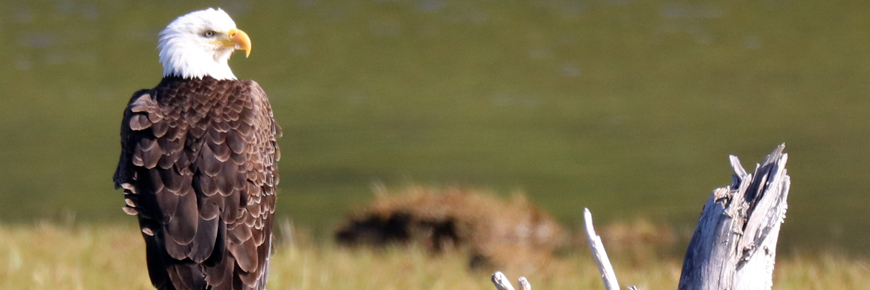
Bald eagle
Cape Breton Highlands National Park
The adult bald eagle is a very large, dark brown to nearly black bird with a white head and tail. Its beak and legs are yellow. The immature bald eagle quickly attains adult size but lacks the white head and tail of the adult. The bald eagle feeds mainly on fish, but eats carrion whenever possible. In winter the bald eagle may kill and eat birds such as gulls and sea ducks.
Nests are usually in tall trees although they may occasionally be on cliffs; the nest is built of branches and sticks and can be very large. The female bald eagle lays 2 (rarely 3) eggs beginning in mid-April. Both the male and female actively hunt and care for the young.
Distribution
The bald eagle breeds from northwestern Alaska, the Mackenzie Delta, the Ungava Peninsula and Newfoundland south to the Gulf of Mexico.
Cape Breton - Nova Scotia's bald eagle haven
Most of the Nova Scotian breeding bald eagle population is found on Cape Breton in the summer - in a 1984 survey, nearly 80% of the occupied bald eagle nests in Nova Scotia were found in Cape Breton.
The Nova Scotian population of bald eagles is important because of how few bald eagles were left in much of northeastern North America after widespread use of the pesticide DDT began. In fact, the bald eagle was considered an endangered species in the United States for many years. However, the Nova Scotian population of bald eagles remained relatively healthy and unaffected by DDT. Some Nova Scotian birds were sent to the United States to help re-establish the bald eagle populations in New Jersey and Massachusetts in the 1980s.
The bald eagle is one of the largest birds of prey in North America, with a wingspan of around two metres—about as wide as a professional basketball player is tall! Bald eagles take about 4 years to reach maturity. The call of a bald eagle is a harsh cackle like "kweek-kik-ik-ik-ik-ik-ik" or a lower "kak-kak-kak."
Bald eagles and other predatory birds are often at the top of the food chain. Toxins get more and more concentrated in animals that approach the top of the food chain, so a healthy population of birds of prey can be a good indicator of overall ecosystem health.
Related links
- Date modified :